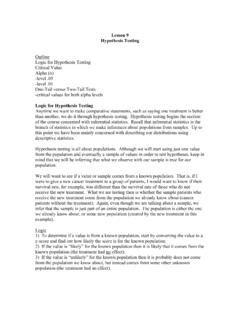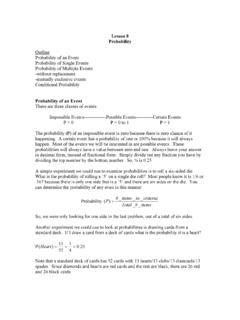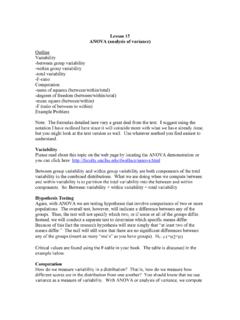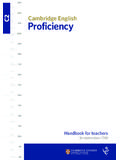Transcription of Lesson 14 Independent Samples t-test
1 Lesson 14 Independent Samples t-test Outline No Population Values Changes in Hypotheses Changes if Formula -standard error Pooled Standard Error -weighted averages Critical Values -df Sample Problem No Population Values With the Independent Samples t-test we finally reach the point where we have no population values. This fact is important because when we test hypotheses we are usually testing an idea and a population that we know nothing about. Think about the kinds of scientific discoveries you hear about often.
2 New treatments for diseases, new drugs, or new techniques for improving depression all involve testing a population created by the treatment or drug or technique. So, with the Independent Samples t-test we will compare two sample values directly. Note that we are still making the inference about the populations from which the Samples are drawn. Changes in Hypotheses All hypotheses from this point on in the course will be two-tailed. In addition, since we no longer no any population values we will use mu to represent both populations.
3 So for example, H0: diet = placebo H1: diet placebo Formula Changes Recall the formula for the t-test we have been using: t=X sx , where sx =sn The numerator will now have two sample values)(21XX instead of one sample and one population. The denominator, recall, is the standard error (the standard deviation divided by the square root of the sample size). Our standard error (denominator) was: sx =sn Remember that the standard error measures variability we expect to see among Samples .
4 Now that we have two Samples we will want to include the estimate of variability from both. Thus, we will have to take into account the standard deviations and sample sizes of both Samples . We will compute the standard error separately for each sample and then add them together. Because of the formula we will develop, it will be easier if we switch from using the standard deviation to the variance. In this way we can eliminate the radical in the denominator. The two formulas are equivalent: ns = ns2 Since we are adding the two separate standard errors together we have: 22212121nsnssXX+= Notice that we now denote the combined standard error with (21 XXs ).
5 Again, it s just a way to symbolize the final value we will divide into the numerator. 21)(21 XXsXXt = where sX 1 X 2=s12n1+s22n2 Pooled Standard Error Note that the formulas I present in this section differ from your text! The above formula is useful when our sample sizes are the same. However, in situations where our sample sizes are different, we cannot simply add the two standard errors together. Instead we have to give more weight to the larger sample. Weighted Averages Let s say I have one sample with N = 20 S = Another sample has: N = 100 S = 15 Although this example is extreme, you can see that you would not want to simply average the two groups together in order to get the average of S.
6 If we did that we would have the average of two groups rather than the average of all 120 people. Simple average of two groups: 15 + = Weighted average of 120 people: )20( )100(15==+=++ For the weighted average we are multiplying each variance times the sample size to get a sum of all 120 people, and in the final step we divide by the total number of people. You can see that if I have 100 people with such a large variance that the average of those people plus 20 more of them with a small standard deviation should yield a value closer to the larger group ( ) than the smaller group ( ).
7 When we have unequal sample sizes we will want to use a similar process to average or pool the variances from our two Samples . Below is the formula that does just that. Notice that we are doing the same process we used for the weighted average above. We multiply the variances times the sample size and divide by the total number of people. The value n-1 or degrees of freedom is used to represent the sample size. ()()211212222112 + + =nnsnsnsp Here 2ps is the symbol we use for the pooled variance. Once we compute that value we plug it into the same formula we used with equal sample sizes, but now denote the variance as pooled.
8 21)(21 XXsXXt = sX 1 X 2=sp2n1+sp2n2 Critical Values We will use the same table to find the critical values as we did with the one-sample t-test . However degrees of freedom are now computed from two Samples , so: df=n1+n2 2 Sample Problem A new program of imagery training is used to improve the performance of basketball players shooting free-throw shots. The first group did an hour imagery practice, and then shot 30 free throw basket shots with the number of shots made recorded. A second group received no special practice, and also shot 30 free throw basket shots.
9 The data are below. Did the imagery training make a difference? Set alpha = .05. X1 X2 15 5 17 6 20 10 25 15 26 18 27 20 Step 1: Write the hypotheses in words and symbols H1: The population receiving imagery practice will make a different number of baskets than the population receiving no imagery practice.
10 H0: The population receiving imagery practice will make a different number of baskets than the population receiving no imagery practice. H1: imagery. no imagery H0: imagery = no imagery Step 2: Find the critical value for the test Since alpha is .05, and it is a two-tail: tcritical = Step 3: Run the test Since we have equal sample sizes (n s) for each group we can use the first (shorter) formula: 21)(21 XXsXXt = where sX 1 X 2=s12n1+s22n2 All the values are given above, so you just have to plug and compute.














